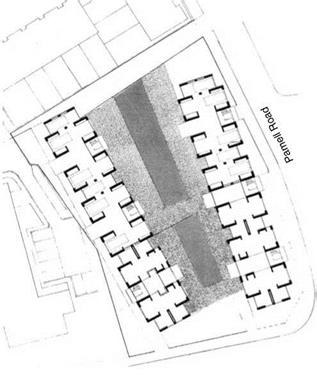Katrin Bohn and Andre Viljoen
SIZE
Figure 24.1 contrasts the size of a nineteenth century London park with proposals for a modest CPUL intervention. It is not the size of an individual urban agriculture site that determines its success as a Productive Urban Landscape. Size will be significant in determining the yield and hence the environmental impact of urban agriculture sites (see Chapter 3), but it is not critical in relation to the qualities brought to a city. We need to distinguish between individual plot size and the extensiveness and interconnectivity of productive urban landscapes. It is interconnectivity that will lead to continuous landscapes, which can ultimately generate a new Ecological Infrastructure in urban environments. Productive urban landscapes may consist of many small fields covering an extensive area, or of isolated patches of horticulture set far apart, or of large individual fields. Fingers of productive landscape may link, like bridges, associated but physically isolated activities and areas of the city. Any one piece of land supporting urban agriculture may vary in size from several square metres in area to several hectares. Implementing productive urban landscapes may start at a small scale, but the goal is to develop CPULs. At its greatest extent, a network of green spaces would overlay and run through the urban fabric, with agricultural fields placed within a continuous landscape.
The authors, have tested the idea of CPULs in a number of design studies. LeisureESCAPE, is a study for one of several strands of continuous landscape, which could be introduced into London (see Plate 6). The study examines an area running south of the Tate Modern art gallery, in the city centre, and continuing for about twenty kilometres to the edge of Greater London, where the continuous landscape disperse into the countryside. A detailed image of part of this scheme shows the relatively modest number of roads required to be given over to growing to create an extensive network of productive urban landscapes. (see: colour plate 8)
Productive landscapes and urban agriculture can exist at a much more modest scale, when located within the boundary of a particular site. Figure 24.2 shows a modest proposal for such a small-scale intervention, sited between two blocks of live work apartments. This landscape would be like a shared square, like a small version of the crescents found in Bath, or expanded versions of Berlin courtyard apartments. These micro fields would be used daily by residents living in adjacent buildings and thus planting would be somewhat more ornamental in character, soft fruits and berries, for breakfasts of strawberries and pears ripe from trees outside a bedroom window.
It is probable that in many instances the courtyard or square will provide a model for Productive Urban Landscapes. In Figure 24.3 we can see plans for a riverside development, which places a number of urban agriculture fields between a riverbank promenade and terraces of apartments and houses. Here the situation closely resembles examples found in Cuba, as seen in Plates 4 and 5.
Productive Urban Landscapes need not be horizontal. Certain places in a city may be appropriate for vertical landscapes, where one or more layers of vegetation are placed vertically against a building’s facade. These second skins provide ecological and environmental benefits. They also provide connections between ground-based fields and cultivated aerial platforms, offering a further degree of ecological intensification, this time an expansion of ground area. Vertical landscapes present a particular form of ecological intensification, by artificially increasing the carrying capacity of a piece of ground.
 |
This intensification requires very specific design and maintenance once implemented. Dealing with the difficulties associated with gardening in shallow soils, at heights where exposure to drying, cold,
and overshadowing is frequently extreme, will limit the application of vertical landscapes to particular sites and buildings. The expert management required for vertical landscapes suggests that they
Figure 24.1 Victoria Park CPUL: A modest CPUL adjacent to Victoria Park in North London. interventions like these retain the character of larger CPULs and may in the future, be extended.
о«г«<‘В0“1
Figure 24.2
 are best developed at a large scale on a single building or on a cluster of smaller buildings, thus facilitating maintenance by a team of dedicated farmer/gardeners. Plate 15 and Figure 24.14 show one example of the integration of vertical fields within a dense development in the city of London.
are best developed at a large scale on a single building or on a cluster of smaller buildings, thus facilitating maintenance by a team of dedicated farmer/gardeners. Plate 15 and Figure 24.14 show one example of the integration of vertical fields within a dense development in the city of London.



